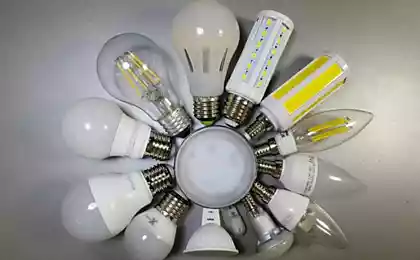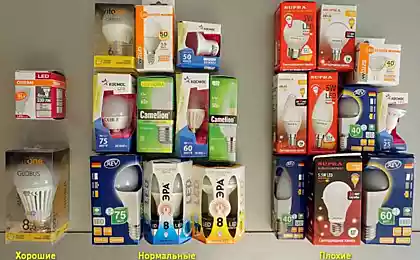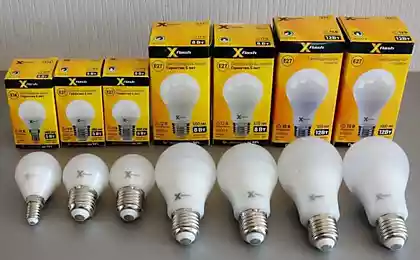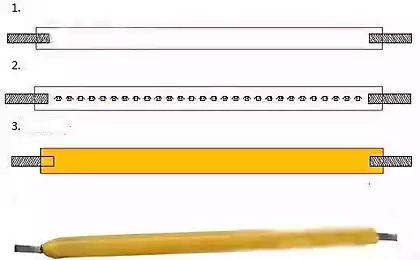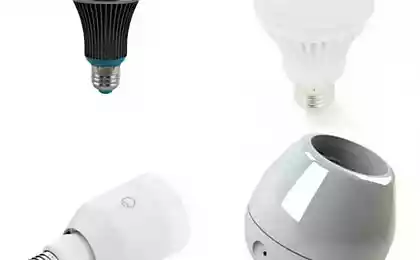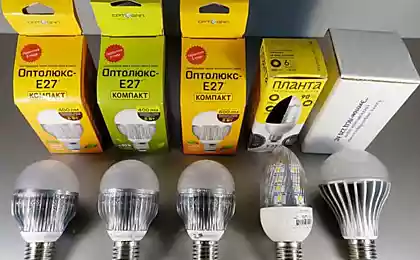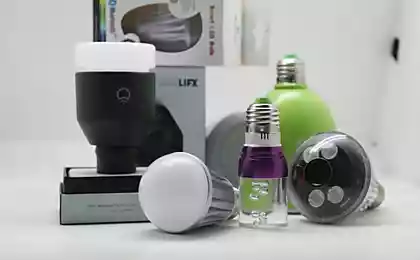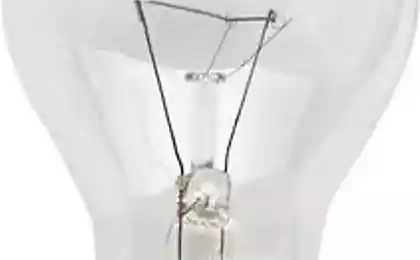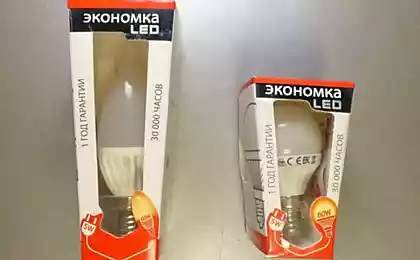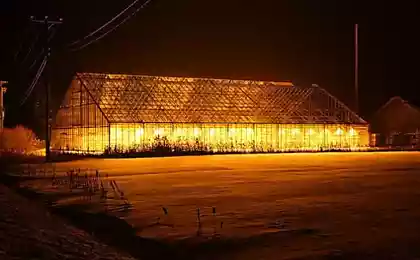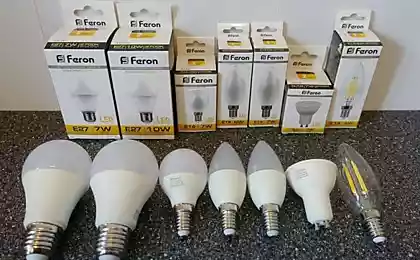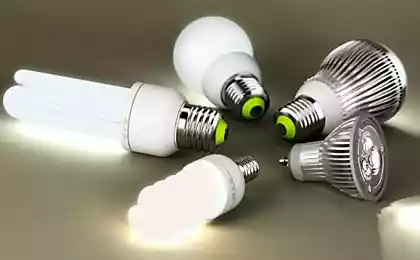829
Type LED lamps and fluorescent lamps against L
Type LED lamps and fluorescent lamps against incandescent light bulbs. Little-known facts about their safety.
Source: my article.
In Russia, Europe and other countries gradually legislated ban incandescent light bulbs, arguing that such lamps warm longer than light. Instead, it offers so-called energy-saving lamps (fluorescent lamps often and, rarely, LED).
But why so much talk about energy efficiency, it is silent, that many so-called new energy-saving lamps cause harm to health? Ergonomics and safety of new bulbs did not worked, there are no standards regulating the most important parameters of the new lamps.
Energy-saving lamps may flicker, color temperature and spectrum of the radiation does not correspond to the incandescent lamp. Tentative economic benefits. And environmental problems.
Since I have very sensitive eyesight and the Internet subject lamps little information, I decided myself to investigate this matter and take place in the home testing different light.
Lamps for testing

LED lamp Gauss 7W (analogue 75W), color. pace. 4200K
Price: 926 rubles
LED lamp Kreonix 4W (analogue 40W), color. pace. 3000K
Price: 890 rubles
Compact fluorescent lamp Uniel 15W (analogue 75W), color. pace. 2700K
Price: 150 rubles
Compact fluorescent lamp Gauss 13W (analogue 60W), color. pace. 2700K
Price: 98 rubles
Bulb 40W and 75W, color. pace. 2544K [1]
Price: 8 RUB
Extras. Equipment: Camera Canon 550D. Color temperature
Is it possible to find the exact replacement of the warm yellow light incandescent bulbs? The answer is - no. Compact fluorescent lamps Uniel and Gauss with a color temperature of 2700K stated and LED Kreonix 3000K issued colder light than incandescent lamp. The difference was obvious to the naked eye. And the inability to find an adequate replacement is very depressing. Other energy-saving lamps with a warm color temperature Not available. Here is a photo (left - incandescent 40W, the right LED Kreonix 4W, equivalent to 40W)
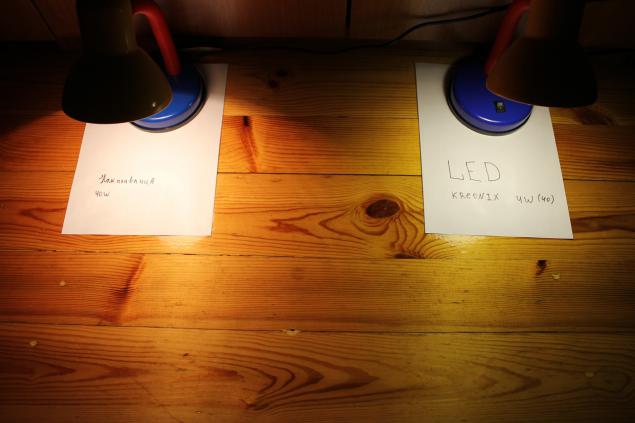
Blink
All fluorescent and incandescent bulbs have no visible flicker. However, the Canon 550D camera in video mode has recorded a slight flicker. The frequency of the AC in the network - 50 Hz. Inertia glow filament or gas in the fluorescent lamps (plus electronic ballast), almost smooth and pulsation amplitude of the brightness variation is small. I have no instrument to measure how much interest is reduced brightness at the point of failure, but feels not much can a few percent that seamlessly eye.
Kreonix 4W LED lamp proved a complete failure. It could be seen flickering even with the naked eye. Here it is necessary to make a digression. The fact that the LEDs did not have the inertia of the glow (no persistence) and in order to get rid of flickering electronic ballast is needed to smooth the ripple current. It seems that the lamp Kreonix saved on capacitors and so this lamp flickers unpleasant. An indirect indication of the absence of the electronic ballast, perhaps is the absence of a radiator cooling the lamp.
But Gauss 7W LED light bulb is pleasantly surprised by the complete absence of any visible flicker. Even the camera is nothing fixed. It looks like the lamp very well smoothed electric current. The lamp has a massive heat sink (photo above).
See. Videotape. To make visible flicker, I picked up the shutter speed and the camera set the exposure manually (1/160, 4.0, ISO 400). In reality, of course this is not flicker, but the video helps to make a comparative comparison flickering lamps to each other. By the way when a camera's exposure sunlight does not detect any flicker.
The emission spectrum
LED bulbs and have a continuous spectrum of radiation, like sunlight
But fluorescent lamps will almost always have a line spectrum of the radiation. It is only 5 bands in the visible range, which can distort color and tired eyes. Subjectively, we can see the white light of a lamp, but in fact it is defective.
The following illustration from Wikipedia [2] (top incandescent 60W, less fluorescent lamp 11W)
Wikipedia says that with the help of a CD, you can see the difference between these lamps. I tried to take a picture, the picture below. Live, of course easier to see that the reflection of a fluorescent lamp on the hard disk steps (sharp gradation) on a rainbow, a rainbow from an incandescent lamp has a smoother tones.
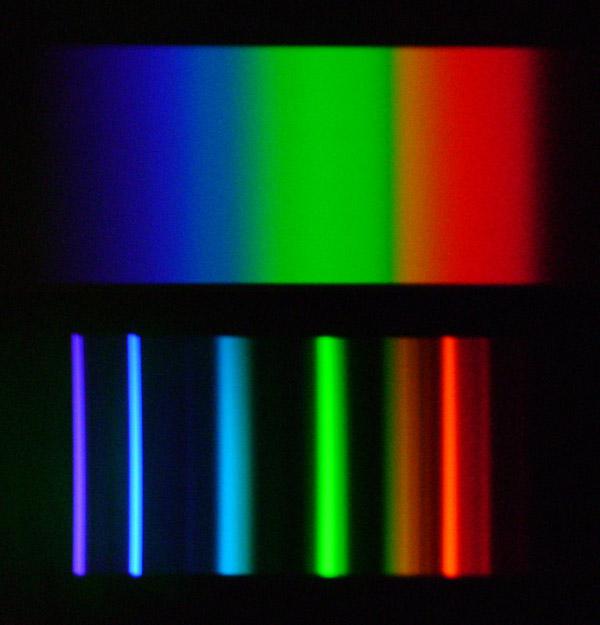
More

Ecology and economy
This is what became known in December 2010, with respect to fluorescent lamps:
"President of the European Committee on Industry, Research and Energy, MEP Herbert Royle (Herbert Reul) in an interview with the Hamburg newspaper Die Welt has promised to do everything that will be in his power to lift the ban on the sale of incandescent light bulbs, operating since 2009.
& lt; ... & gt;
Federal Office for the Environment at the beginning of December, spread information about the dangers to human health, which could cause contained in energy-saving lamps mercury. The Office presented data of the current study, according to which, if the energy-saving lamp inadvertently break, the mercury concentration in the room is 20 times higher than the permissible 0, 35 micrograms per cubic meter of air. Do not resolved the issue with the disposal of end-of-period allotted energy-saving lamps: adequate infrastructure for collection is not created, and most contain dangerous mercury "housekeepers" to finish their days on normal landfills, where they do not belong. When energy saving calculations do not take into account the energy consumption for the production of energy-saving lamps and their proper disposal: they are much higher than for standard incandescent bulbs, and virtually nullify the expected energy savings. "[3]
You can imagine how will be shipped with mercury chutes in doorways and dumpsters near the houses.
Conclusions
It is puzzling ban incandescent bulbs, while both still have not created a substitute for these lamps. Of course, there is hope for LED lamps, but they still need to modify substantially - to solve the problem of the color temperature, and most importantly make sane prices for these lamps.
The main problem - too many new important parameters in the new energy-saving lamps on which people have no idea. If the incandescent lamps all have the same good quality of light, fluorescent and LED lamps have a different quality of light. The manufacturer does not indicate on the box, there is flickering lamp, which she emission spectrum (a line or continuous) is often not warned about the proper disposal of the lamp. All of this was supposed to work out before the introduction of the state of unreasoned prohibitions.
Igor Kokarev
February 7, 2011
_____________
[1] The color temperature is taken from the website: plasma.karelia.ru/ ~ ekostq / PUBLIC / Opt_Lab / 5 / 5.html < br /> [2] ru.wikipedia.org/wiki/%D0%9A%D0%BE%...%BC%D0%BF%D0%B0
[3] www.newsland.ru/news/detail/id/613355/cat/42/
All.
Source:
Source: my article.
In Russia, Europe and other countries gradually legislated ban incandescent light bulbs, arguing that such lamps warm longer than light. Instead, it offers so-called energy-saving lamps (fluorescent lamps often and, rarely, LED).
But why so much talk about energy efficiency, it is silent, that many so-called new energy-saving lamps cause harm to health? Ergonomics and safety of new bulbs did not worked, there are no standards regulating the most important parameters of the new lamps.
Energy-saving lamps may flicker, color temperature and spectrum of the radiation does not correspond to the incandescent lamp. Tentative economic benefits. And environmental problems.
Since I have very sensitive eyesight and the Internet subject lamps little information, I decided myself to investigate this matter and take place in the home testing different light.
Lamps for testing

LED lamp Gauss 7W (analogue 75W), color. pace. 4200K
Price: 926 rubles
LED lamp Kreonix 4W (analogue 40W), color. pace. 3000K
Price: 890 rubles
Compact fluorescent lamp Uniel 15W (analogue 75W), color. pace. 2700K
Price: 150 rubles
Compact fluorescent lamp Gauss 13W (analogue 60W), color. pace. 2700K
Price: 98 rubles
Bulb 40W and 75W, color. pace. 2544K [1]
Price: 8 RUB
Extras. Equipment: Camera Canon 550D. Color temperature
Is it possible to find the exact replacement of the warm yellow light incandescent bulbs? The answer is - no. Compact fluorescent lamps Uniel and Gauss with a color temperature of 2700K stated and LED Kreonix 3000K issued colder light than incandescent lamp. The difference was obvious to the naked eye. And the inability to find an adequate replacement is very depressing. Other energy-saving lamps with a warm color temperature Not available. Here is a photo (left - incandescent 40W, the right LED Kreonix 4W, equivalent to 40W)

Blink
All fluorescent and incandescent bulbs have no visible flicker. However, the Canon 550D camera in video mode has recorded a slight flicker. The frequency of the AC in the network - 50 Hz. Inertia glow filament or gas in the fluorescent lamps (plus electronic ballast), almost smooth and pulsation amplitude of the brightness variation is small. I have no instrument to measure how much interest is reduced brightness at the point of failure, but feels not much can a few percent that seamlessly eye.
Kreonix 4W LED lamp proved a complete failure. It could be seen flickering even with the naked eye. Here it is necessary to make a digression. The fact that the LEDs did not have the inertia of the glow (no persistence) and in order to get rid of flickering electronic ballast is needed to smooth the ripple current. It seems that the lamp Kreonix saved on capacitors and so this lamp flickers unpleasant. An indirect indication of the absence of the electronic ballast, perhaps is the absence of a radiator cooling the lamp.
But Gauss 7W LED light bulb is pleasantly surprised by the complete absence of any visible flicker. Even the camera is nothing fixed. It looks like the lamp very well smoothed electric current. The lamp has a massive heat sink (photo above).
See. Videotape. To make visible flicker, I picked up the shutter speed and the camera set the exposure manually (1/160, 4.0, ISO 400). In reality, of course this is not flicker, but the video helps to make a comparative comparison flickering lamps to each other. By the way when a camera's exposure sunlight does not detect any flicker.
The emission spectrum
LED bulbs and have a continuous spectrum of radiation, like sunlight
But fluorescent lamps will almost always have a line spectrum of the radiation. It is only 5 bands in the visible range, which can distort color and tired eyes. Subjectively, we can see the white light of a lamp, but in fact it is defective.
The following illustration from Wikipedia [2] (top incandescent 60W, less fluorescent lamp 11W)
Wikipedia says that with the help of a CD, you can see the difference between these lamps. I tried to take a picture, the picture below. Live, of course easier to see that the reflection of a fluorescent lamp on the hard disk steps (sharp gradation) on a rainbow, a rainbow from an incandescent lamp has a smoother tones.

More

Ecology and economy
This is what became known in December 2010, with respect to fluorescent lamps:
"President of the European Committee on Industry, Research and Energy, MEP Herbert Royle (Herbert Reul) in an interview with the Hamburg newspaper Die Welt has promised to do everything that will be in his power to lift the ban on the sale of incandescent light bulbs, operating since 2009.
& lt; ... & gt;
Federal Office for the Environment at the beginning of December, spread information about the dangers to human health, which could cause contained in energy-saving lamps mercury. The Office presented data of the current study, according to which, if the energy-saving lamp inadvertently break, the mercury concentration in the room is 20 times higher than the permissible 0, 35 micrograms per cubic meter of air. Do not resolved the issue with the disposal of end-of-period allotted energy-saving lamps: adequate infrastructure for collection is not created, and most contain dangerous mercury "housekeepers" to finish their days on normal landfills, where they do not belong. When energy saving calculations do not take into account the energy consumption for the production of energy-saving lamps and their proper disposal: they are much higher than for standard incandescent bulbs, and virtually nullify the expected energy savings. "[3]
You can imagine how will be shipped with mercury chutes in doorways and dumpsters near the houses.
Conclusions
It is puzzling ban incandescent bulbs, while both still have not created a substitute for these lamps. Of course, there is hope for LED lamps, but they still need to modify substantially - to solve the problem of the color temperature, and most importantly make sane prices for these lamps.
The main problem - too many new important parameters in the new energy-saving lamps on which people have no idea. If the incandescent lamps all have the same good quality of light, fluorescent and LED lamps have a different quality of light. The manufacturer does not indicate on the box, there is flickering lamp, which she emission spectrum (a line or continuous) is often not warned about the proper disposal of the lamp. All of this was supposed to work out before the introduction of the state of unreasoned prohibitions.
Igor Kokarev
February 7, 2011
_____________
[1] The color temperature is taken from the website: plasma.karelia.ru/ ~ ekostq / PUBLIC / Opt_Lab / 5 / 5.html < br /> [2] ru.wikipedia.org/wiki/%D0%9A%D0%BE%...%BC%D0%BF%D0%B0
[3] www.newsland.ru/news/detail/id/613355/cat/42/
All.
Source:
